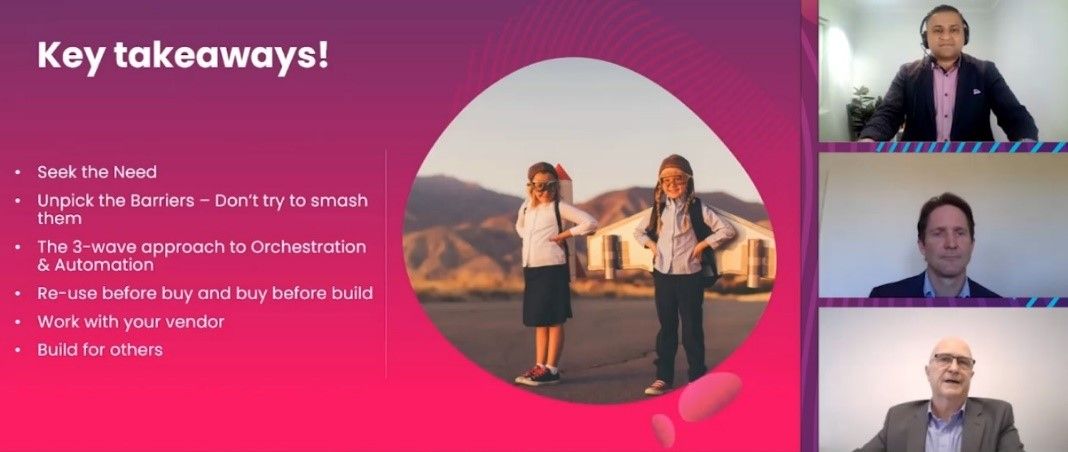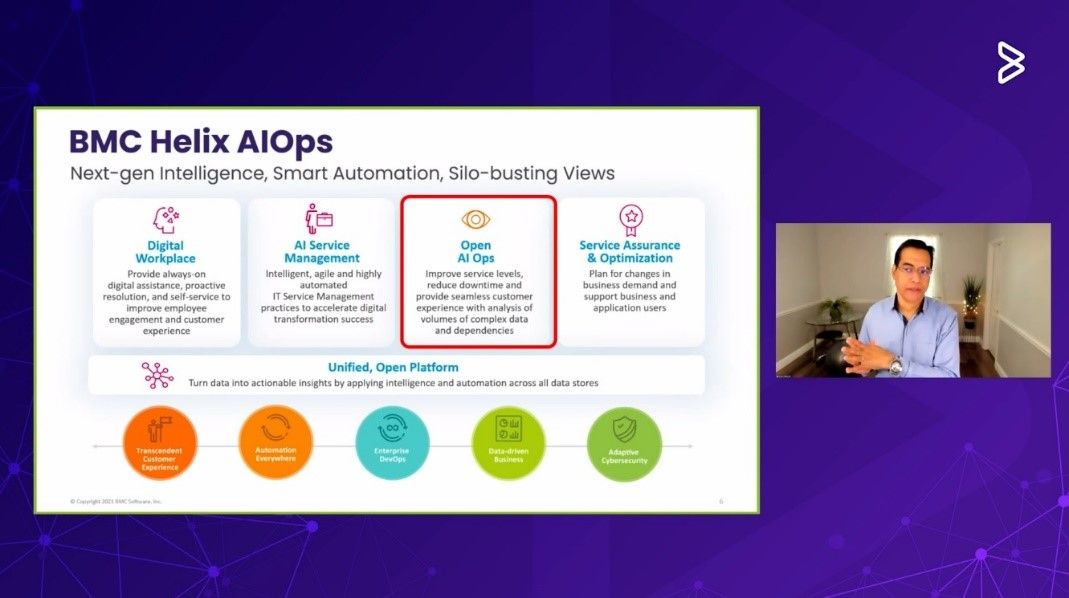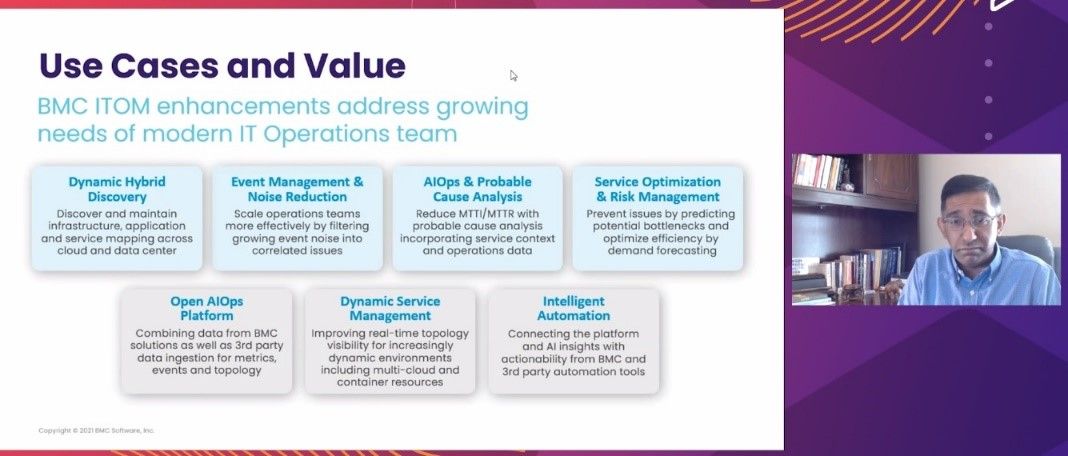At BMC Exchange 2021, three sessions focused on the topics of operations management and artificial intelligence for operations (AIOps), exploring how machine learning (ML) capabilities proactively address IT complexity to deliver real-time, enterprise-wide observability, insights, and automated remediation.
It Can’t Be Done: A Story of 15 Years of Automation in Telstra
In their session at BMC Exchange 2021, Telstra’s Technology Product Owner, Roy Partington, and Group Principal, Bryce Howie, took us through their 15-year journey and shared their challenges, lessons learned, and successes.
Telstra is the 12th largest company on the Australian stock exchange with revenue of around $17 billion annually and an asset base around $30 billion, providing a range of services to consumers, small business, enterprise, government, and wholesale customers split between mobile and fixed services in the telecommunication industry—and more recently, the energy industry.
Telstra’s IT operations arm performs over 35+ million orchestrations per month, and after a series of restructures, the most recent evolution has 16 million of the company’s estimated 25 million employees now working in an agile model—and they’re 80 percent completed on a three-year transformation, with a strong focus on digitalization.
Partington and Howie have seen their share of changes at the company. According to Partington, one key ingredient to riding out recurring cycles of change is being able to respond nimbly and work with what they have. “[Whether] it’s a system capability or…key processes outside of the traditional, out-of-the-box stuff that came with TrueSight Orchestration, we will just build everything and reuse before buying. For us [that] is the way that we stayed ahead of that pack,” he says.
“We were able to say, ‘We can do this. We can build this solution for a fraction of the cost that somebody else is quoting within the IT environment.’ For example, they were charging something like $130,000, just for a simple integration that took us two days.”

“This is why we use vendor products,” says Howie. “We can also solve it by leaning on the vendor…and tapping into their expertise and knowledge to help us solve a problem. Working closely with…BMC has provided us a lot of support. And we’re entering into this phase where we’re partnering on developing and…this is how our journey will continue. We’re into the next phase…where we’re looking at…the next evolution of the orchestration capability.”
That next evolution will be focused on how to integrate Telstra’s sprawling toolset. “When I look across Telstra, there’s probably 15 to 20 different automation and orchestration tools available…and being used by different parts of the business,” shares Howie.
“Where I see the opportunity is bring[ing] it together so that we can make them available to a broader set of users [in a] single place that’s like a marketplace and [they] can see what’s available, understand how it’s being used. We can monitor the performance of the automations and use orchestration to coordinate and tap [into] the different ones that are available now. That gives a broader set of people a better understanding and more informed choices.”
To view the full session, click here (it’s free to register)!
Accelerate MTTR with AIOps and Log Analytics
In this session, BMC’s Sam Lakkundi, VP of Innovation at BMC, and Anuj Gupta, Principal Product Manager, explained how to enrich the log data produced by your systems and combine it with the power of AIOps to find problems quickly and take proactive action before they impact your customers. Log analytics can help reduce the mean time to detect (MTTD), mean time to identify and isolate (MTTI), and mean time to resolve (MTTR) problems and issues your operations team might be facing.
Lakkundi level set by defining log analytics as the process of searching, analyzing, and visualizing machine data generated by IT systems and technology infrastructure to gain operational insights for what you need within the organization. The benefits of getting ahead of issues before they start include millions of dollars in savings and preventing direct costs like lost revenues and penalties and indirect costs of customer dissatisfaction and attrition.

According to Lakkundi, traditional data tools are simply not big enough for the current, and growing, variety and volume of this machine data. That’s where BMC Helix Operations Management comes in, using predictive capabilities to proactively improve the performance and availability of IT services across hybrid and on-premises environments.
BMC Helix Operations Management uses AIOps for monitoring anomaly detection, advanced event management, and root cause analysis to reduce MTTR and maximize service performance and availability. It’s the only end-to-end, AI-driven software-as-a-service (SaaS) platform that gives organizations the ability to manage the complexity and scale of IT operations to deliver fast value.
To view the full session, click here (it’s free to register)!
BMC Helix IT Operations Management Roadmap
In its session, the BMC Helix IT Operations Management team previewed upcoming developments on the solution roadmap. The team discussed how BMC is supporting customers in an increasingly dynamic world and applying AI and machine learning (ML) to reduce noise and enable better event management than in the past.
“The reality is you can’t simply scale by adding people to that equation. You have to leverage technology. And that’s where really AI/ML comes in, being able to reduce that noise and being able to identify…the true signal that you need to be able to respond to in your environment,” says Joseph George, Vice President of Product Management for IT Operations Management Products at BMC.
“[It’s also important to identify] the root cause of problems, whether it’s a performance degradation [or] an outage. How do you get to the root cause…ahead of time…so you can take corrective actions? That’s already available…through our BMC Helix platform. It’s what we’re continuing to enhance.” Those enhancement also include integrating with third-party tools, being able to reconcile huge volumes of data, and creating a single view.

“We can bring in data from multiple tools, and not just metrics and events, but also topology data, because you’ve got those tools that have a different view of the world. We can now bring that into the [BMC] Helix platform and reconcile that to create a single underlying topological view of your environment,” adds George.
Discovery is also key. “You’re dealing with an increasingly changing environment. You can’t just run discovery once a day anymore,” he explains. “You’ve got to be able to have a really good view of your environment on a much more real-time basis.”
Anthony Bryce, Director of Product Management at BMC, discussed the importance of service modeling and acknowledged that if it’s burdensome for customers, they don’t do it, so automating it is imperative. He says the next release will offer a new service modeling user experience that’s drag-and-drop oriented and supports more dynamic data structures, in addition to the start-anywhere application modeling that customers are familiar with today.
And those are just a few of the highlights from the full roadmap preview. To see the entire session, click here (it’s free to register)!
To see more of the great conversations from BMC Exchange 2021 on demand, visit https://exchange.bmc.com.






